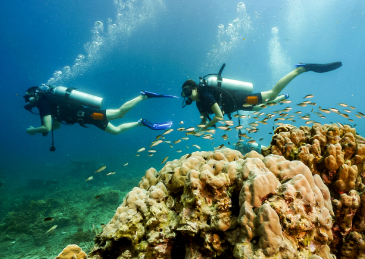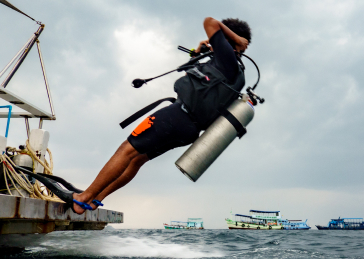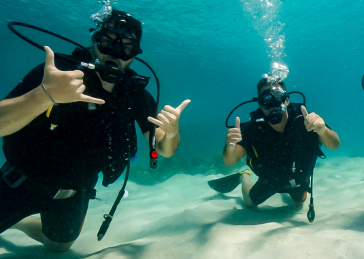10th June 2024
Key Points
Koh Tao is a favourite destination for backpackers aiming to get an open water diving certification due to its affordability and beautiful diving spots.
The open water certification process usually includes theoretical learning, confined water dives, and open water dives to ensure divers are confident and competent.
When choosing a dive center, consider factors such as safety records, instructor experience, group sizes, and eco-friendly practices.
Most dive centers in Koh Tao provide necessary gear, but personal items like a swimsuit, towel, and sunscreen will be needed.
An open water course typically takes 3-4 days to complete, with no prior experience necessary, but basic swimming ability is required.
Plunging into the crystal-clear waters of Koh Tao isn’t just a pastime; it’s a gateway into a world of underwater wonders that many only dream of. For backpackers seeking adventure on a budget, Koh Tao offers the perfect mix of affordability and exotic marine life, making it the perfect place to get your open water diving certification. Here’s why this Thai island is a backpacker’s paradise for diving.
Why Koh Tao is a Backpacker’s Diving Paradise

Picture yourself gliding through the water next to a vibrant coral reef, surrounded by schools of colorful fish, and maybe even a friendly sea turtle or two. That’s what you can expect every day in Koh Tao, where the cost of living—and diving—is surprisingly affordable. For example, an open water course here is a fraction of the price you’d pay in other parts of the world. But it’s not just about the cost; it’s about the quality of the experience, and Koh Tao does not disappoint.
The island’s commitment to diving has fostered a community of fellow adventurers who all share the same love for the sea. The dive sites cater to beginners but also offer enough variety to keep experienced divers coming back. This creates a supportive and stimulating atmosphere for you to begin your diving adventure.
Demystifying the Open Water Certification Process
Though it may seem intimidating at first, the certification process is actually quite simple. It’s divided into three parts: theory learning, confined water dives, and open water dives. You’ll start by learning the theory of diving, which you can even do online before you arrive. Then, you’ll practice in a pool or shallow water to get used to the equipment. Finally, you’ll take the leap into the open ocean, where you’ll do four dives over two days. After that, you’ll be certified to dive anywhere in the world up to 18 meters deep.
You don’t have to worry about bringing equipment; the dive center will provide everything you need, including a wetsuit, mask, and fins. All you need to bring is your adventurous spirit.
How to Select the Perfect Dive Center
Considering the numerous dive schools on the island, it may seem like a daunting task to find the right one. However, I’ve got your back with some crucial advice to ensure you make the right choice.
What to Look for When Choosing a Dive School
Safety is Key: Look into the dive center’s safety record and inquire about their procedures in case of an emergency. Safety should always be at the top of your list.
Small is Better: Opt for small group sizes, which will give you more one-on-one time with the instructor, something that can be very important for beginners.
Environmentally Conscious: Pick a school that values and respects the ocean. We want to keep the waters of Koh Tao clean for future generations.
Experienced Instructors: Make sure your instructor is experienced and has been certified by a reputable agency like PADI, RAID or SSI. They should be someone who makes you feel comfortable and confident while you’re underwater.
Most importantly, trust your instincts. Visit the dive centers, have a chat with the instructors, and pick the place that feels right for you. Keep in mind, you’re about to embark on the adventure of a lifetime, and having the right guide can make all the difference.
Getting the Most for Your Money: Balancing Cost and Quality
Scuba diving is not an activity where you want to cut corners on quality. While it may be tempting to choose the least expensive option, it’s important to make sure you’re not compromising the quality of your training. A reputable dive school will have clear, up-front pricing with no hidden fees, and the price should include equipment rental, instruction, and certification costs.
For the full open water course, the typical price ranges from ฿9,000 to ฿11,000 (roughly $275 to $335 USD), often including accommodation. When you look at global prices, it’s clear why Koh Tao is an easy choice for backpackers on a budget.
Getting Physically and Mentally Ready
Before you start, there are some things you need to prepare. Physically, you need to be able to swim and not get tired easily. You don’t have to be an athlete, but you do need to be comfortable in the water. Mentally, you need to be open to learning new things. There’s a lot to learn, but your instructors will help you.
Remember, you need to study as well! To pass your certification, you need to understand the theory behind diving. It’s not as difficult as rocket science, but it is indeed a science. You will learn about buoyancy, pressure, and how to plan a dive. Above all, pay attention to how you’re feeling. If you feel sick or nervous, let your instructor know. Their job is to make sure you’re safe and having a good time.
What to Expect from the Open Water Course

Get ready for four days of excitement and hard work. The course may be intense, but it is built for those with no prior experience. You’ll begin with theory, which can be done online or in a classroom, then you’ll head to shallow waters to practice your skills. On the third day, you’ll be in the ocean, and by the fourth day, you’ll be a certified diver. It may be a lot to take in, but it is an experience you won’t forget.
Day by Day Overview
On the first day, you’ll be introduced to your instructor and the equipment you’ll be using. You’ll also begin your dive theory lessons. The second day is when things start to get exciting as you’ll get in the water for the first time to practice your skills in a controlled environment. The third and fourth days are when you’ll put your skills to the test in the open water, diving among the fish and coral. These are the days that you’ll remember forever, the first time you truly feel like you’re a part of the underwater world.
Skills You’ll Acquire and Perfect
The course will teach you crucial skills such as setting up your equipment, clearing your mask underwater, and controlling your buoyancy. You’ll also learn safety procedures, like what to do if you run out of air. But it’s not just about skills; it’s about becoming comfortable and confident underwater. By the end of the course, you’ll be doing things you might never have imagined, like sharing air with a buddy and navigating underwater.
Keep in mind, the education doesn’t cease once you’ve earned your certification. Diving is a never-ending adventure, with each dive offering an opportunity to improve your abilities and discover new depths.
Under the Sea: Exploring Koh Tao’s Dive Sites

“GREAT BARRACUDA LIFE EXPECTANCY” from www.worldlifeexpectancy.com and used with no modifications.
Let’s move on to the dive sites. Koh Tao is home to more than 20 dive sites, each with its own unique appeal. From shallow coral gardens to deeper pinnacles, there’s a dive site for divers of all skill levels. The warm, clear waters make for a comfortable dive and offer great visibility, allowing you to fully enjoy the surrounding marine life.
What an array of life awaits! Tropical fish swarm in schools, corals flaunt their colors, and if fortune favors you, you might spot a whale shark. This rich biodiversity is what makes Koh Tao a haven for divers.
If you’re a newbie, you’ll probably begin at spots like Japanese Gardens or Mango Bay where the waters are serene and the depths are easy to handle. However, as you become more comfortable, you can explore places like Chumphon Pinnacle or Southwest Pinnacle, where the depths and currents provide a completely different thrill.
For instance, my first dive after getting my certification was at The Twins, which are two small pinnacles located close to each other. This is where I had my first encounter with a sea turtle, a moment that I will never forget. The peaceful creature was as interested in me as I was in it, and we had a short, peaceful swim together before we went our separate ways.
Top Sites for Novices
If you’re just starting out, you’ll want to find locations that are easy and not overly deep. Koh Tao has a lot of these. Here’s where you should begin:
Japanese Gardens: This is a great spot for your first dive because of its shallow depths and calm waters.
Mango Bay: This site is popular for training dives because of its easy conditions and abundance of fish.
Twins: This site features two pinnacles and a variety of marine life, making it a great place to practice navigation.
These sites are more than just training grounds; they’re teeming with life and beauty. You’ll be surprised by what you can see, even in the shallows.
Once you’ve been on a few dives, you’ll start to identify different types of fish and creatures, and you’ll begin to feel comfortable in the water. That’s when you know you’ve caught the diving bug.
Must-See Marine Life Encounters
The real treasure of Koh Tao is its marine life. Here are some encounters you absolutely must see:
Whale Sharks: These are the largest fish in the sea and a rare sight that fills you with awe and wonder.
Sea Turtles: Swimming with these graceful and serene creatures is a dream come true for many divers.
Barracudas: The sight of impressive schools of barracudas on a dive is a mesmerizing spectacle.
These encounters are more than just opportunities for taking pictures; they’re moments that connect you with the wonder of nature. And that’s what diving is all about.
What to do After Certification: Your Next Move
After getting certified, the world is your playground—or, in this context, your coral reef. You can continue to dive in Koh Tao, discover new locations, and improve your abilities. Alternatively, you can use your certification to dive in other parts of the world. The decision is yours, and it’s a fantastic one.
However, if you’re anything like most divers, you’ll want to continue your education. This is where advanced courses come into play. These courses can elevate your diving, enabling you to dive deeper and take on more difficult dive sites.
Don’t forget about the social side of diving. You’ll meet other divers from all corners of the globe, each with their own unique stories and experiences. Diving isn’t just an activity; it’s a community, and it’s one that warmly welcomes new members.
Further Courses and Specialties
Once you’ve completed your open water course, you might think about the following:
Advanced Open Water: This is a step up from the Open Water course and includes deep diving, navigation, and three other specialty dives that you get to choose.
Rescue Diver: This course is all about learning how to prevent and manage problems in the water, and become more confident in your skills as a diver.
Specialties: If you have a specific interest in diving, like wreck diving or underwater photography, there’s a specialty course for you.
Each of these courses builds on what you learned in the open water course, giving you more skills, more confidence, and more reasons to get in the water. So, why wait? The water’s fine, come on in!
Being a part of the diving community goes beyond just exploring the world beneath the waves. It’s about joining a worldwide family with a shared love of the sea. As divers, we have a duty to protect the marine environment we love so much. By choosing eco-friendly dive centers and following responsible diving practices, we can reduce our impact and help keep the ocean safe for the generations to come. It’s an amazing feeling to know that every dive can help with conservation.
Becoming Part of the Dive Tribe: The Social and Environmental Impact
As you become a certified diver, you’re not just picking up a new pastime; you’re becoming part of a global tribe. Divers share a unique connection, a passion for the ocean that goes beyond language and culture. Dive centers and boats are social hotspots, places where tales are exchanged, friendships are forged, and future dive plans are hatched.
However, this isn’t all fun and games. Divers are often the first to see the effects of pollution and climate change, putting them at the forefront of ocean conservation. By choosing to dive with centers that prioritize eco-friendly practices, you are contributing to the health of our oceans. Plus, you’ll learn how to dive in a way that is safe and sustainable for marine life.
FAQ
What’s the difference between PADI and SSI certifications?
Both PADI (Professional Association of Diving Instructors) and SSI (Scuba Schools International) are globally recognized certification bodies. The key difference between them is their teaching methods and flexibility. PADI is known for its structured, consistent approach and widespread recognition. On the other hand, SSI offers more flexibility in the learning process. Both certifications are accepted worldwide, so you can choose the one that best fits your learning style.
What is the duration of the Open Water Course?
The Open Water Course typically requires around 3 to 4 days to finish. This encompasses classroom theory, confined water dives for skill practice, and four open water dives. The pace can be different based on the dive center and your comfort level, but don’t worry, you’ll have ample time to learn and relish the experience.
For instance, Sarah, a backpacker from Canada, was able to finish her Open Water Course in only three and a half days. She picked a dive center that provided a flexible schedule, which enabled her to partake in other island activities without feeling hurried during her training.
What is the youngest age you can be to get Open Water Certified?
The youngest age you can be to get Open Water Certified is 10 years old for most agencies. However, younger divers may have certain restrictions until they’re older, such as depth limits and the need to dive with a professional or certified parent/guardian.
Is it necessary for me to know how to swim to enroll in the course?
Indeed, you must possess fundamental swimming abilities to participate in the Open Water Course. You don’t need to swim like an Olympian, but you should feel at ease in the water. The majority of dive centers necessitate that you show your capacity to swim 200 meters and float or tread water for 10 minutes.
What if I’m scared to dive?
It’s completely normal to feel scared, especially if you’re a beginner. The most important thing is to let your instructor know. They are trained to help you feel safe and secure in the water. Take your time, practice your breathing, and remember that it’s okay to take a break if you need to. Eventually, your fear will turn into excitement as you get used to the underwater world.
Dive with LBD: Your Gateway to Underwater Exploration
Whether you’re a curious beginner or a seasoned pro, our school is your portal to the wonders of scuba diving. Join us into the world beneath the waves.
READY TO GET STARTED?
Check our diving courses in Koh Tao



